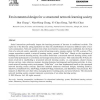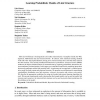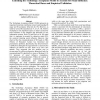178 search results - page 18 / 36 » Representing social structures in UML |
IMCS
2007
13 years 8 months ago
2007
Purpose – This paper aims to report on the results of an analysis of the computer security problem space, to suggest the areas with highest potential for making progress in the ...
CE
2007
13 years 8 months ago
2007
Social interactions profoundly impact the learning processes of learners in traditional societies. The rapid rise of the Internet using population has been the establishment of nu...
JMLR
2002
13 years 8 months ago
2002
Most real-world data is heterogeneous and richly interconnected. Examples include the Web, hypertext, bibliometric data and social networks. In contrast, most statistical learning...
CSE
2009
IEEE
14 years 17 days ago
2009
IEEE
Massively Multiplayer Online Role Playing Games (MMORPGs) are computer based games in which players interact with one another in the virtual world. Worldwide revenues for MMORPGs h...
HICSS
1999
IEEE
14 years 28 days ago
1999
IEEE
The Technology Acceptance Model (TAM) represents an important theoretical contribution toward understanding IS usage and IS acceptance behaviors [6, 19]. However, as noted by seve...



